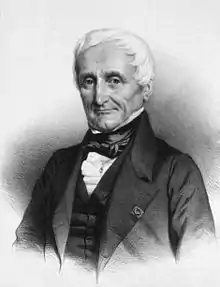André Marie Constant Duméril
André Marie Constant Duméril (1 January 1774 – 14 August 1860) was a French zoologist. He was professor of anatomy at the Muséum national d'histoire naturelle from 1801 to 1812, when he became professor of herpetology and ichthyology. His son Auguste Duméril was also a zoologist, and the author citation Duméril is used for both André and his son.
André Marie Constant Duméril | |
|---|---|
 | |
| Born | 1 January 1774 |
| Died | 14 August 1860 (aged 86) |
| Education | University of Rouen |
| Known for | Zoologie analytique |
| Children | Auguste Duméril |
| Awards | Académie des Sciences, American Philosophical Society, commander of the Légion d'Honneur |
| Scientific career | |
| Fields | Zoology |
| Institutions | Muséum national d'histoire naturelle |
| Author abbrev. (zoology) | Duméril |
Life
André Marie Constant Duméril was born on 1 January 1774 in Amiens and died on 14 August 1860 in Paris.
He became a doctor at a young age, obtaining, at 19 years, the prévot of anatomy at the medical school of Rouen. In 1800, he left for Paris and collaborated in the drafting of the comparative anatomy lessons of Georges Cuvier.
He replaced Cuvier at the Central School of the Panthéon and had, as his colleague, Alexandre Brongniart. In 1801, he gave courses to the medical school of Paris. Under the Restauration, he was elected a member of the Académie des Sciences (French Academy of Sciences) and after 1803 succeeded Lacépède, who was occupied by his political offices, as professor of herpetology and ichthyology at the Muséum national d'histoire naturelle. Duméril only officially received this chair in 1825, after the death of Lacépède.
He published his Zoologie analytique in 1806. This covered the whole of the animal kingdom and shows the relations between genera as then distinguished, but not among species. He was elected a member of the American Philosophical Society in Philadelphia in 1813.[1] In 1832, Gabriel Bibron (1806–1848), who became his assistant, was given the task of describing the species for an expanded version of Zoologie analytique, while Nicolaus Michael Oppel (1782–1820) assisted him with a revised higher-order systematics. After the death of Bibron, he was replaced by Auguste Duméril, André's son. However, Bibron's death delayed the publication of the new work for 10 years. In 1851, the two Dumérils, father and son, published the Catalogue méthodique de la collection des reptiles (although Auguste was apparently the true author) and in 1853, André Duméril alone published Prodrome de la classification des reptiles ophidiens. This last book proposes a classification of all the snakes in seven volumes.
Duméril, upon discovering a case of preserved fishes in the attic of the house of Georges-Louis Leclerc, Comte de Buffon, finally described the species that had been collected by Philibert Commerson nearly 70 years earlier.
He then published a very important work, l’Erpétologie générale ou Histoire naturelle complète des reptiles (nine volumes, 1834–1854). In this, 1,393 species are described in detail and their anatomy, physiology, and bibliography are specified. However, Duméril maintained the amphibians among the reptiles in spite of the work of Alexandre Brongniart or Pierre André Latreille or the anatomical discoveries of Karl Ernst von Baer (1792–1876) and Johannes Peter Müller (1801–1858).
He was interested all his life in the insects and published several memoirs on entomology. His principal entomological work is Entomologie analytique (1860, two volumes). With his son Auguste, also a zoologist, he created the first vivarium for reptiles of the Jardin des Plantes. Duméril always considered observations on animal behaviour of taxonomic significance.
After 1853, he began to cede his position to his son and he retired completely in 1857. He was made a commander of the Legion of Honour two months before his death.
Species named after A.M.C. Duméril
- The worm Platynereis dumerilii Audouin & H. Milne-Edwards, 1834
- The Greater Amberjack fish Seriola dumerili Risso, 1810[2]
- The bryozoan, Callopora dumerilii Audouin & in de Savigny, 1826
- The moth Luperina dumerilii Duponchel, 1826
- The isopod Rocinela dumerilii Lucas, 1849
- The aquatic isopod crustacean Sphaeroma dumerilii Leach, 1818
- The Filefish Cantherhines dumerilii Hollard, 1854[3]
- The Lizard Acanthodactylus dumerilii (H. Milne-Edwards, 1829)[4]
- The Boa Snake Acrantophis dumerili Jan in Jan & Sordelli, 1860[4]
- The wolf snake Lycodon dumerili (Boulenger, 1893)[4]
- The coral snake Micrurus dumerilii (Jan 1858)[4]
- The Amazon River Turtle Peltocephalus dumerilianus (Schweigger, 1812)[4]
- The lizard Stenocercus dumerilii (Steindachner, 1867)[4]
- The Snake Urotheca dumerilii (Bibron, 1840)[4]
- The Monitor Lizard Varanus dumerilii (Schlegel, 1839)[4]
See also
References
- Le Floch-Prigent, P (December 2008). "Constant Duméril (1774–1860) anatomist doctor and naturalist, about a portrait by G. Devers". Morphologie: Bulletin de l'Association des Anatomistes. France. 92 (299): 199–203. doi:10.1016/j.morpho.2008.08.003. ISSN 1286-0115. PMID 18951057.
- "APS Member History". search.amphilsoc.org. Retrieved 2 April 2021.
- Christopher Scharpf & Kenneth J. Lazara (22 September 2018). "Order CARANGIFORMES (part 1): Families LATIDAE, CENTROPOMIDAE, LACTARIIDAE, SPHYRAENIDAE, LEPTOBRAMIDAE, TOXOTIDAE, NEMATISTIIDAE, MENIDAE, XIPHIIDAE, ISTIOPHORIDAE, CORYPHAENIDAE, RACHYCENTRIDAE, ECHENEIDAE and CARANGIDAE". The ETYFish Project Fish Name Etymology Database. Christopher Scharpf and Kenneth J. Lazara. Retrieved 19 January 2023.
- Christopher Scharpf & Kenneth J. Lazara (22 September 2018). "Order TETRAODONTIFORMES: Families MOLIDAE, BALISTIDAE, MONACANTHIDAE, ARACANIDAE and OSTRACIIDAE". The ETYFish Project Fish Name Etymology Database. Christopher Scharpf and Kenneth J. Lazara. Retrieved 19 January 2023.
- Beolens, Bo; Watkins, Michael; Grayson, Michael (2011). The Eponym Dictionary of Reptiles. Baltimore: Johns Hopkins University Press. xiii + 296 pp. ISBN 978-1-4214-0135-5. ("Duméril", p. 77).